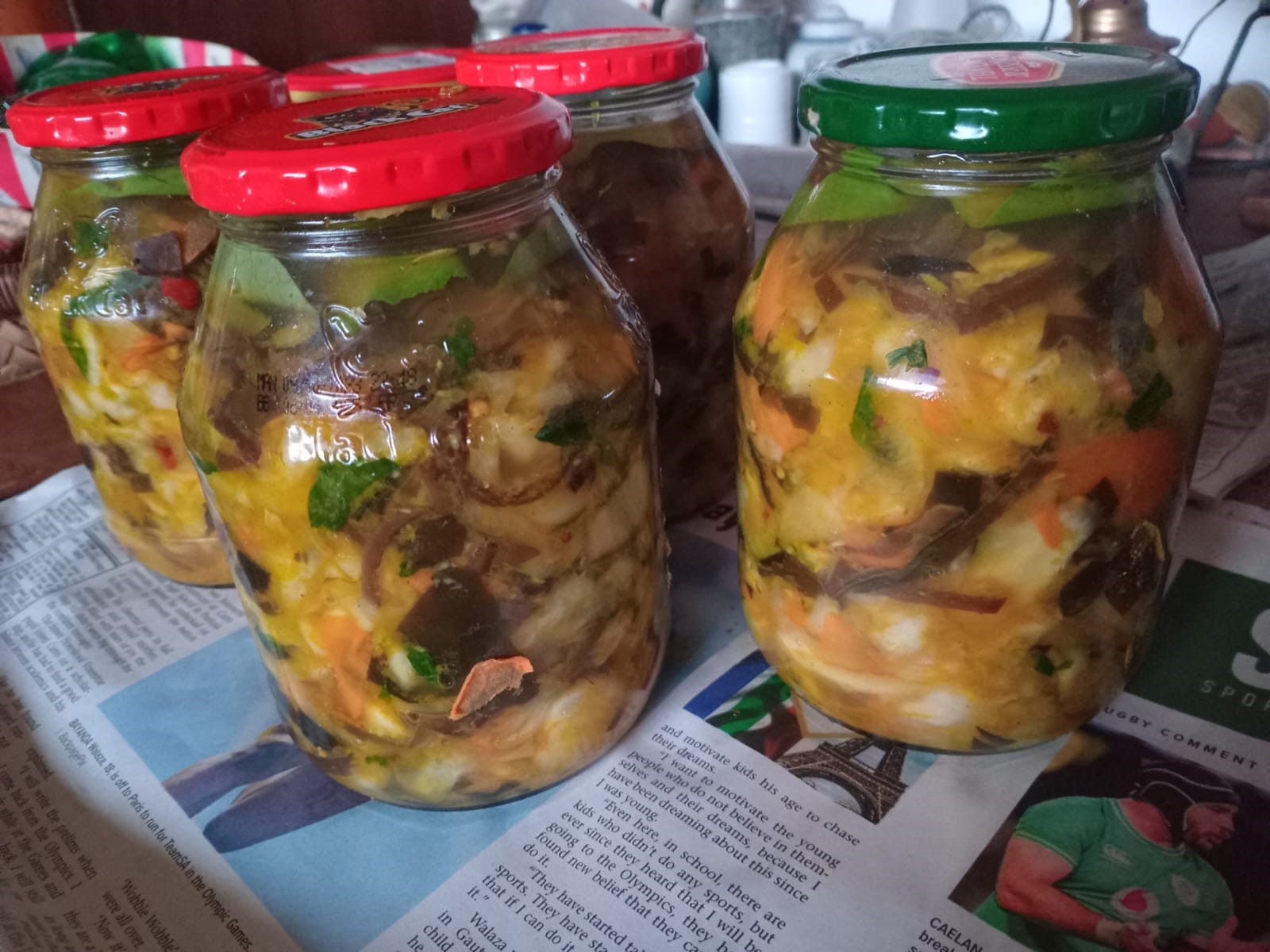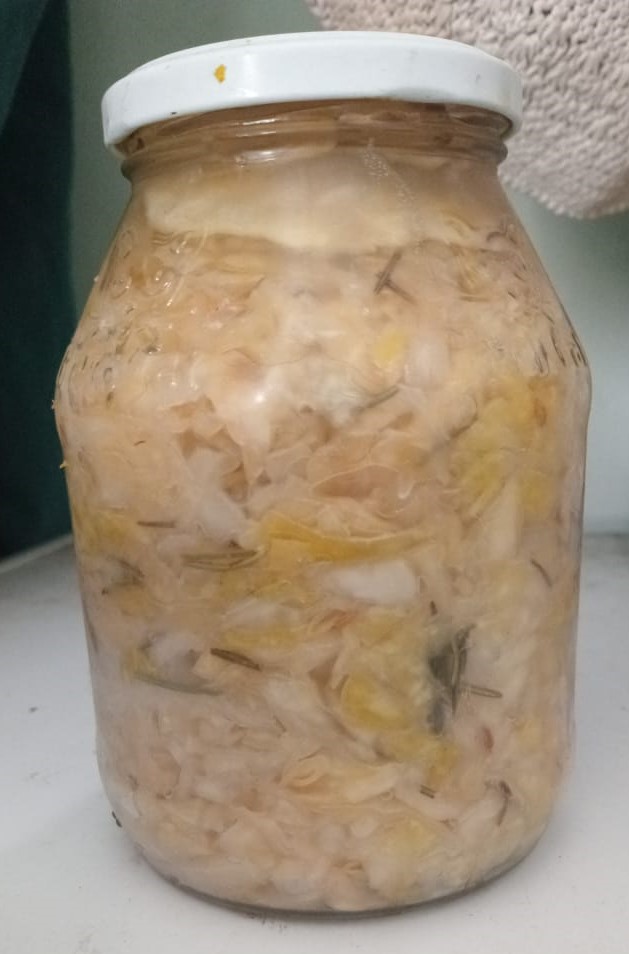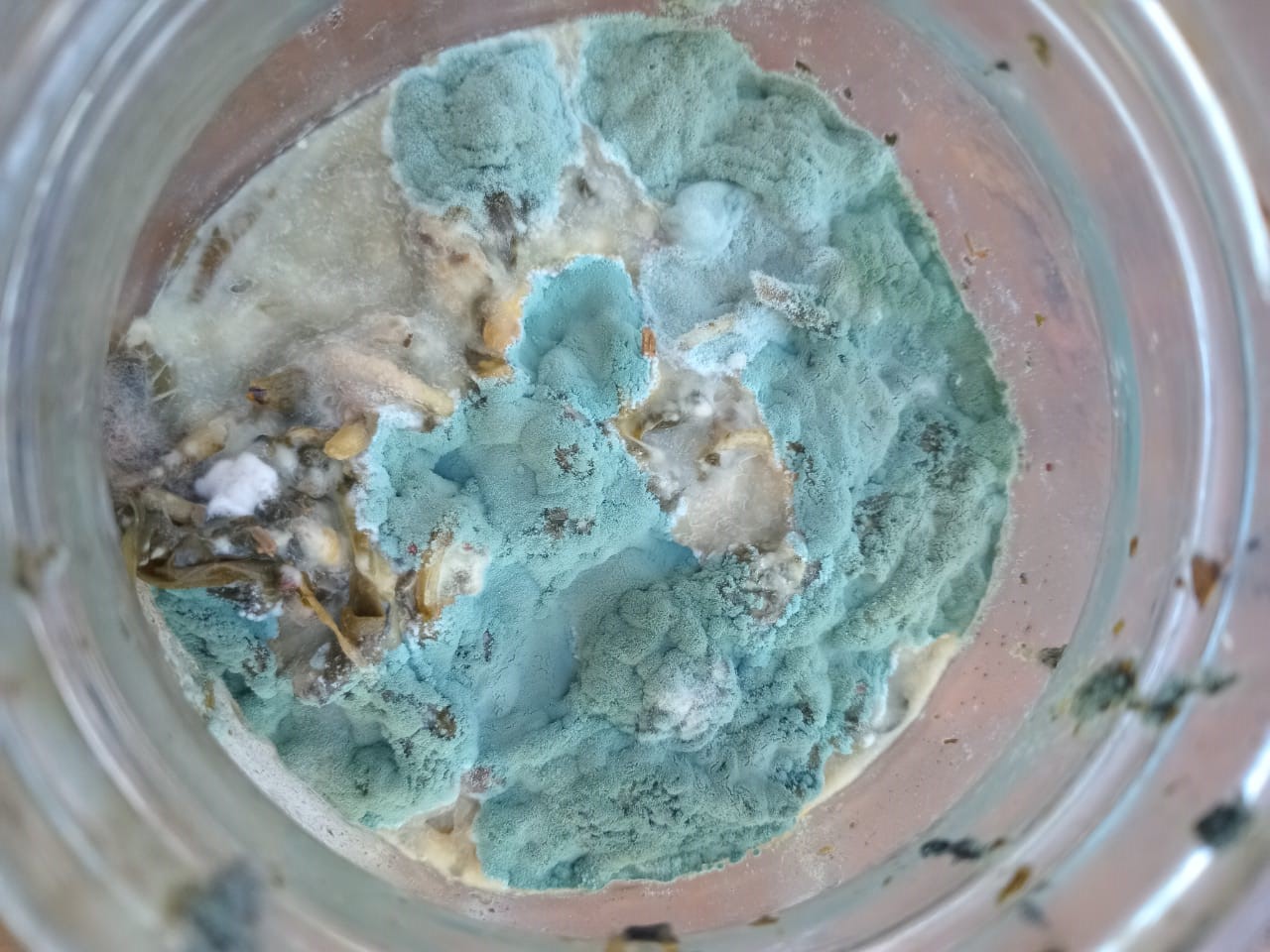Dear Reader, in this age of AI created content, please support with your goodwill someone who works harder to provide the human-made. Sign up at the top of the lefthand column or bottom of this page. You will receive my hand illustrated monthly newsletter RESTORE NATURE and access to the biodiversity garden design course as I write...and nothing else, I respect your time. I am also removing the advertizing as best I can as its become intrusive inappropriate and pays me nothing.
My own version of Kimchi
 Colourful kimchi pickle in recycled peanut butter jars
Colourful kimchi pickle in recycled peanut butter jarsAlthough it is a traditional Korean relish, the choice of ingredients is flexible and very much up to personal taste. Thus making Kimchi allows a lot of freedom. Staying within the broad gamut of commonly recommended ingredients in recipes, I created my own, based on the preferences of my own taste buds, a desire to make something that would perhaps boost my health, and staying within the salt ratios of classic kraut recipes. I will explain how this recipe differs from 'normal' kimchi as I go.
Reasons to make kimchi
Kimchi is a delicious addition to food. Like kraut, or lacto fermented vegetables, it is rich in probiotics. This does come with a down side, as aflatoxins sometimes are present in small quantities, so I am very careful these days. Kimchi is often made with seaweed and a lot of healthy spices, so these nutritional elements were also a motivation.
 A simple but very delicious sauerkraut success due to bottling it right.
A simple but very delicious sauerkraut success due to bottling it right.Master kraut recipe
I generally make kraut (fermented vegetables) by weighing my prepared vegetables and then adding 2% non iodized course salt by weight, sprinkled over the surface and rubbed in. I let the vegetables wilt, sometimes pounding them to produce more moisture. After a day or so with cabbage, I bottle it and press it down really hard till there is a layer of liquid at the surface. I've found it effective to add, over this, a circle of cabbage leaf cut to size, to hold down the kraut below. I can't afford special pickling or fermenting jars but that would be nice as they automatically keep the veggies submerged and the mass oxygen free. I don't add water or brine as its seldom necessary.
Recently I pickled a blend of garden greens that needed cutting back and it grew blue grey mold ontop, as I had not submerged them properly and did not refrigerate, which is not so wise in a warm climate. It has to be thrown away. I will put it in a bucket in the garden soaking in water to remove the salt and then after a week or so, pour the water down the sewer and compost the fermented vegetables.
This failure was followed by a very successful sauerkraut where I used the circles of cabbage leaf, and refrigerated after a week. It was flavored with jeera or cumin, rosemary and little herb robert and was, still is, delicious ! It has encouraged me to make a small batch of kimchi.
 When you neglect submerging kraut in the glass, sealing the bottle properly and refrigerating on time this can happen. DO NOT CONSUME !!!! but isn't it beautiful ?
When you neglect submerging kraut in the glass, sealing the bottle properly and refrigerating on time this can happen. DO NOT CONSUME !!!! but isn't it beautiful ?Sterilizing the jars
I sterilize my jars by adding boiling water right up to the top, taking care to increase the heat slowly or they crack. The lids are placed on top, and very loosely screwed on. They are then left to cool, and the water poured out just before bottling. The peanut butter jars seem to give a better seal than mason jars. I did use a mason jar without rubber grommets on the garden greens and weed ferment, which may be why it failed, as oxygen and pathogens could get in.
Some differences to classic kimchi
Kimchi is normally started with brine to wilt the cabbage. I don't like to do that because the brine may be the right concentration, but the vegetable content varies, as the weight is not specified, and thus the salt concentration in the vegetables can vary.
The cabbage is wilted in brine from a few hours to overnight before any other vegetables are added. I pre wilted the cabbage for two hours in pure salt crystals, and added a cup of whey that I happened to have.
The brine is usually poured off before the other vegetables are added, but I did not do this, wishing to retain the nutrients in the cabbage which have leached out with the plant sap.
Finally a spicy, salty paste is added, often sandwiched between the cabbage leaves which are left large, and then rolled up. This means the kimchi ferments almost dry, whereas mine was pretty wet and submerged in liquid. I also chopped the cabbage fine.
This should definitely affect the flavor profile. It probably isn't really kimchi anymore, but rather a kraut with kimchi-esque ingredients.
Choice of ingredients
Kimchi paste is often made with starches and sugars and I excluded these as I'm on a two week elimination diet and don't want refined carbs. Instead I used a pear and an onion, often used in kimchi recipes, and blended them to make a wet paste to which I added the spices.
I chose to make a kimchi with seaweed. Not all kimchi recipes include it, but I chose it as it contains iodine and minerals and I want to supplement with those to see if they affect my thyroid health and general wellbeing positively. This seems strange when I always use uniodated salt in kraut as iodine suppresses fermentation, but I guess that the natural version is more dilute and will not do this. I added about twice the usual quantity of seaweed.
Seaweed can also contain pollutants like mercury, but excluding all possible contaminants is very difficult and in my successive elimination progression I will try to cut out heavy metals at a later stage. Just how to do this without compromising the diversity of my (or anyone's) diet is still problematic, but cheers to the military industrial complex and the way they have poisoned the rest of us.
I added mushrooms for umami flavor, on top of the umami of the seaweed.
Some of my favorite flavorants are garlic and ginger, part of most kimchi recipes. I added mustard as I like it, and pepper and turmeric for their reputed health giving benefits.
Kimchi is normally flavored with about four times the amount of chili. I like hot food but chose to try it with less.
I made up the pickle with cabbage being only 1/3 of the vegetable weight, which isn't really usual, but I used what I had available. The rest was made up by Daikon radish, carrots, a pear, an onion, and green onion.
Scroll down for another recipe which worked better.
The ingredients
1kg cabbage thinly sliced
1 cup fresh whey
5 Tablespoon (82 ml) course uniodated salt
6 garlic cloves
a large finger of ginger
1 pear
1 onion
1 bunch of green onion
4 carrots
2 medium Daikon radish to make up a total vegetable weight
½ teaspoon mustard seed
4 teaspoons Cayenne chilli flakes
l teaspoon paprika
2 teaspoons turmeric
½ teaspoon white pepper
1 cup dry seaweed from an Asian store
1 cup finely sliced dried mushrooms from an Asian store
The recipe
1kg cabbage thinly sliced
1 cup fresh whey
1 Tablespoon (16ml) course uniodated salt
Chop the cabbage fine, sprinkle with salt and whey and leave to wilt for 2 hours stirring often
Weigh up 2 kg of vegetables including
6 garlic cloves
a large finger of ginger
1 pear
1 onion
*
1 bunch of green onion
4 carrots
2 medium Daikon radish to make up a total vegetable weight
½ teaspoon mustard seed
Set aside the garlic, ginger, pear and onion. Mix the whole mustard and rest of the diced vegetables with the cabbage.
2 tablespoons (33 ml) uniodated salt
Add salt to diced veg and cabbage and and leave for 2 hours stirring frequently.
1 cup dry seaweed
1 cup finely sliced dried mushrooms
Moisten dried seaweed and dried mushrooms till soft in 2% brine made with 1 liter of water and 1 tablespoon of salt
Drain the seaweed and chop finely, and add to vegetables
Cook the mushrooms in the soaking water for 15 mins. Cool and add to vegetables.
Mince or blend the garlic, ginger, pear and onion, using only a little juice from cabbage if required.
Blend the following into the mixture in blender.
4 teaspoons Cayenne chilli flakes
l teaspoon paprika
2 teaspoons turmeric
½ teaspoon white pepper
Mix the blended ingredients in with the vegetables
Bottle, squeezing the pickle down into the jar so that there is a good bit of liquid on top
I added some of the seaweed brine on top and then a lid of pak choi leaves to keep the liquid down. Add some salt.
½ teaspoon salt per jar
Ferment for 3 days at room temp, cautiously releasing pressure without contaminating the pickle daily, then refrigerate.
salt content
I added 2% salt by weight to all ingredients except the seaweed, which should have its own salt, and soaked in 2% brine should have been adequately salted. The mushrooms were dry, and I didn't know how to calculate for dry food. I should have soaked them in brine too as I've specified in the recipe. However the seaweed brine I topped up with was of unknown salt concentration, the whey, mushrooms and dried spices were salt free, so my salt may have been a bit low. I added 1/4 teaspoon extra salt on top of each jar just in case.
A recipe which felt much better
I've tasted the kimchi and its good but could be a lot more spicy. I didn't notice any positive health effects. Further research revealed that cabbage is a goitrogen, interfering with the production of thyroid hormone, if mildly.
I made a new mix with
a cup of pure seaweed
a cup of dried mushrooms
2 cups of chlorine free water
a teaspoon of iodized salt
boiled for 15 minutes, blended with a stick blender and soured with
two tablespoons of natural vinegar
to cut some of the seaweed 'ick'.
Please refrigerate and sniff regularly for off odours.
The high salt and smattering of vinegar should make it keep but considering all the nutrients in seaweed, and its microbiome habituated to high salt conditions, please play it safe
This thick savoury 'sauce' on my food a teaspoon a day I find delicious and flavor enhancing. It made a bigger difference to my feeling of being correctly nourished which I believe you can feel deep down in your toes, like a kind of rising bubbling energy.
Garden lover's anecdotes in afterthought
Looking at pictures of the Jardin Serre de la Madone, established by the extremely wealthy Major Lawrence Johnstone who also created the famous gardens of Hidcote Manor in Britain. The garden realizes dreams which for people like self just remain dreams, but at least the ridiculously rich can execute on them and what happens can be interesting and educational.
Serre de la Madone was originally a farmhouse with olive terraces to which the major added 2 large wings (I wouldn't have, even if I had the mulas, it probably destroyed the rural ambience), and formal and informal gardens. He was a plant collector, and this French garden had many plants from other Mediterranean climate zones, ranging from the Americas to Australia and South Africa. He fled to England during WW2 and returned to a house devastated by the Italian military, but picked up the pieces and started again. Yes it has very little to do with kimchi making, except combining warmth, colour and flavour in a wildly experimental maritime melange, and I admire keeping on with one's obsessions and living to the fullest despite disaster.
home page for links to my articles, all on aspects of natural gardening
biodiversity gardening blog "Garden for Life"
Restore Nature Newsletter
I've been writing for four years now and I would love to hear from you
Please let me know if you have any questions, comments or stories to share on gardening, permaculture, regenerative agriculture, food forests, natural gardening, do nothing gardening, observations about pests and diseases, foraging, dealing with and using weeds constructively, composting and going offgrid.
Your second block of text...
SEARCH
Order the Kindle E-book for the SPECIAL PRICE of only
Prices valid till 30.09.2023
Recent Articles
-
garden for life is a blog about saving the earth one garden at a time
Apr 18, 25 01:18 PM
The garden for life blog has short articles on gardening for biodiversity with native plants and regenerating soil for climate amelioration and nutritious food -
Cape Flats Sand Fynbos, Cape Town's most endangered native vegetation!
Apr 18, 25 10:36 AM
Cape Flats Sand Fynbos, a vegetation type found in the super diverse Cape Fynbos region is threatened by Cape Town's urban development and invasive alien plants -
Geography Research Task
Jan 31, 25 11:37 PM
To whom it may concern My name is Tanyaradzwa Madziwa and I am a matric student at Springfield Convent School. As part of our geography syllabus for this
"How to start a profitable worm business on a shoestring budget
Order a printed copy from "Amazon" at the SPECIAL PRICE of only
or a digital version from the "Kindle" store at the SPECIAL PRICE of only
Prices valid till 30.09.2023







